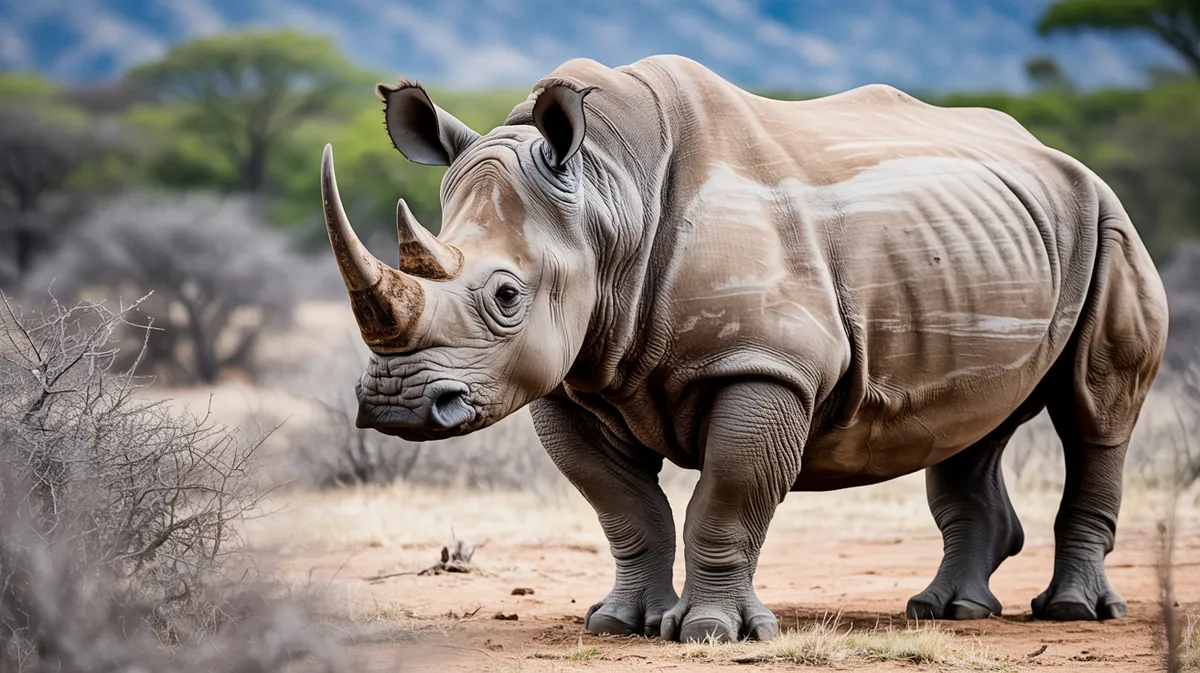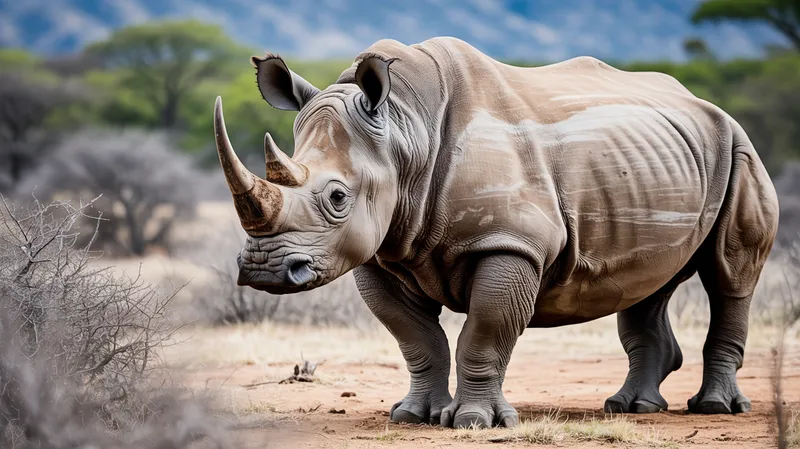
Black Rhinoceros
Diceros bicornis

Meet the Black Rhinoceros
The Black Rhinoceros is a large, thick-skinned herbivore native to eastern and southern Africa. Despite its name, its skin color varies from brown to gray, and it is distinguished from the white rhinoceros by its pointed upper lip, which is adapted for grasping leaves and twigs. Black rhinos are generally solitary and have a reputation for their unpredictable and sometimes aggressive behavior. They play an essential ecological role by browsing woody plants and shaping the landscapes of the savannas and scrublands they inhabit.
Classification
Mammal
Habitat
Savanna, shrubland, and dry forest
Diet
Herbivore
Lifespan
35-50 years
Conservation
Critically Endangered
Weight
800-1,400 kg
📖Fascinating Facts
Prehensile Lip
Black rhinos possess a pointed, prehensile upper lip which allows them to grasp and strip leaves from shrubs and trees, unlike the wide, flat lip of the white rhinoceros.
Acute Hearing
Despite poor eyesight, black rhinos have large, swiveling ears that help them detect sounds from potential threats or other rhinos.
Two Horns
Black rhinos have two horns made of keratin, with the front horn typically being larger; these horns are unfortunately the main target for poachers.
📋Detailed Description
The black rhinoceros (Diceros bicornis) is a robust, thick-skinned mammal characterized by two prominent horns on its snout, with the anterior horn typically measuring 50–140 cm and the posterior horn 20–50 cm. Adults stand 140–180 cm at the shoulder and can weigh between 800 and 1,400 kg, with males generally larger than females. Its prehensile, pointed upper lip is a distinctive adaptation for browsing, allowing it to grasp leaves, twigs, and shoots from shrubs and trees. The skin, though tough and up to 1.5 cm thick, is sensitive to sun and insect bites, prompting behaviors such as wallowing in mud for protection. Black rhinos have relatively poor eyesight but compensate with acute senses of smell and hearing. They are primarily solitary, with home ranges that may overlap, though females with calves are an exception. Territoriality is less pronounced than in other rhino species, but individuals mark their ranges with dung and urine. Social interactions are typically brief and can be aggressive, especially among males. Vocalizations include grunts, snorts, and trumpeting sounds, used in communication and during confrontations. Lifespan in the wild averages 35–40 years, with some individuals living longer in protected reserves.
💡 Did you know?
The black rhinoceros population has plummeted by over 95% since 1960 due to poaching and habitat loss, making it one of the rarest large mammals in Africa.
🔬Research & Sources
Wikipedia Summary
The black rhinoceros, also called the black rhino or the hooked-lip rhinoceros, is a species of rhinoceros native to East and Southern Africa, including Angola, Botswana, Eswatini, Kenya, Lesotho, Malawi, Mozambique, Namibia, South Africa, Tanzania, Zambia, and Zimbabwe. Although the species is referred to as black, its colours vary from brown to grey. It is the only extant species of the genus Diceros.
Last Modified: 5/23/2025
🎭Behavior & Social Structure
Black rhinos are predominantly solitary and crepuscular, being most active during dawn and dusk. They spend much of their time browsing for food, using their prehensile lips to strip leaves and bark from woody plants. Daily routines include feeding, wallowing in mud to regulate body temperature and deter parasites, and resting in shaded areas during the hottest part of the day. While generally solitary, temporary aggregations may occur at waterholes or mineral licks. Males are more territorial than females, often engaging in horn displays or physical confrontations to establish dominance. Communication is achieved through scent marking, vocalizations, and body language. Despite their reputation for aggression, most confrontations are ritualized and rarely result in serious injury. Black rhinos are known to investigate unfamiliar scents and sounds, contributing to their unpredictable behavior.
👶Reproduction & Life Cycle
Black rhinoceroses are polygynous, with dominant males competing for access to receptive females. Courtship involves prolonged following, vocalizations, and sometimes aggressive interactions. Mating can be a noisy and prolonged event, lasting up to an hour. Females have an estrous cycle of approximately 21–40 days, and gestation lasts about 15–16 months. Calving typically occurs year-round, though peaks may align with rainy seasons in some regions. A single calf is born, weighing 35–50 kg, and is able to stand and walk within hours. Calves remain with their mothers for up to three years, during which the mother is highly protective. Interbirth intervals are typically 2.5–3.5 years, influenced by environmental conditions and calf survival. Males reach sexual maturity at 7–10 years, females at 5–7 years.
🛡️Adaptations & Survival
The black rhino's prehensile upper lip is a key evolutionary adaptation for selective browsing, enabling it to feed on a wide variety of woody plants, including thorny acacias. Its thick, layered skin provides protection against thorns, predators, and conspecific aggression. Large, mobile ears and a highly developed olfactory system compensate for poor eyesight, allowing detection of predators and conspecifics over long distances. Wallowing behavior helps regulate body temperature and protects against ectoparasites. The rhino's robust body and strong legs are adapted for traversing rugged terrain and dense thickets. Behavioral adaptations include a heightened wariness and aggressive defense responses, which historically reduced predation risk from large carnivores.
📚Research Sources
🎨Cultural Significance
Black rhinos have held symbolic significance in various African cultures, often representing strength, resilience, and the untamed wilderness. In some traditions, rhino horn was believed to possess medicinal or magical properties, though these beliefs lack scientific basis. The species features in local folklore and is a prominent figure in modern conservation campaigns, serving as a flagship species for habitat protection. Internationally, the black rhino is a symbol of the global fight against wildlife trafficking and the importance of biodiversity conservation.
🔬Recent Research & Discoveries
Recent research has focused on the genetic diversity and population structure of black rhinos, using molecular markers to inform translocation and breeding programs. Studies on feeding ecology have highlighted the species' role as a keystone browser, influencing plant community dynamics and promoting habitat heterogeneity. Advances in non-invasive monitoring, such as dung DNA analysis and camera trapping, have improved population estimates and behavioral studies. Ongoing research addresses the impacts of climate change on rhino habitats, disease susceptibility, and the effectiveness of anti-poaching technologies, including drone surveillance and forensic horn analysis. Conservation genetics is increasingly used to manage inbreeding risks in small, isolated populations.
🎥Wildlife Videos

Black Rhinoceros: The Battle for Survival
Black Rhinoceros: The Battle for Survival | Full Wildlife Documentary Join us on a powerful journey into the heart of Africa to ...
Wild Hope

"Black Rhino: Last of the Ancient Horned Giants | An Epic Animal Documentary"
Witness the dramatic survival story of Africa's most endangered megafauna in this breathtaking animal documentary about the ...
Nature’s Notebook

Black Rhino vs White Rhino: What's the Difference?
It's true that rhinos are endangered animals and that there are many organizations working hard to protect them from extinction, ...
Kenya Wild Parks

Saving The Black Rhino
This was an entry into the Warwick Documentary Society Competition 2023. It is a mockumentary based on nature documentaries, ...
Warwick Documentary Society

Black rhinoceros Description, Characteristics and Facts!
Hi, this is animal planet tv channel. Black rhinoceros Description, Characteristics and Facts! my channale name animal planet tv .
animal planet tv

All About -Wild Rhinos Baby Rhinoceros Survival Wildlife
All About Wild Rhinos: Baby Rhinoceros Survival Wildlife Dive into the awe-inspiring world of wild rhinos! In this captivating ...
Art Of Life Insurance
🌍Habitat Information
The Black Rhinoceros typically inhabits Savanna, shrubland, and dry forest environments. Black Rhinoceross have adapted to their environments with specialized features and behaviors.
Primary Habitat:
Savanna, shrubland, and dry forest
More detailed habitat information will be available soon.
🛡️Conservation Status
The Black Rhinoceros is currently classified as Critically Endangered. Conservation efforts are crucial for preserving this species for future generations.
Common Threats:
- 🏠Habitat loss and fragmentation
- 🌡️Climate change impacts
- 🎯Hunting and poaching
- 🏭Human-wildlife conflict
⚠️Threats & Conservation Challenges
The black rhinoceros faces critical threats from poaching, primarily for its horns, which are highly valued in illegal wildlife trade for traditional medicine and ornamental use. Habitat loss and fragmentation due to agriculture, human settlement, and infrastructure development further exacerbate population declines. Disease transmission from livestock and competition for resources also pose challenges. Despite intensive conservation efforts, including translocations, anti-poaching patrols, and community engagement, the species remains Critically Endangered, with fewer than 5,600 individuals estimated in the wild as of 2023. Population recovery is hindered by slow reproductive rates and ongoing illegal hunting. Genetic diversity is a concern, particularly for isolated subpopulations.
🔬Scientific Classification
Scientific Name
Diceros bicornis
Classification Hierarchy
🔍 About Taxonomic Classification
Taxonomic classification is a hierarchical system used by scientists to classify and organize living organisms based on shared characteristics and evolutionary relationships.
The system moves from broad categories (Kingdom) to increasingly specific ones, with each animal's scientific name typically consisting of its Genus and species.
📝Community Notes
Share your observations and insights about the Black Rhinoceros with our community of wildlife enthusiasts.
Join Our Community
Sign in to share your observations and connect with fellow wildlife enthusiasts.
Sign In to ContributeNo community notes yet
Be the first to share your observations about the Black Rhinoceros!
Explore Black Rhinoceros
Select a tab above to learn more about this amazing animal.
📸Photo Gallery
No photos available for this animal yet.
🌟Discover More Wildlife
Continue your journey of discovery with more fascinating animals from our database
